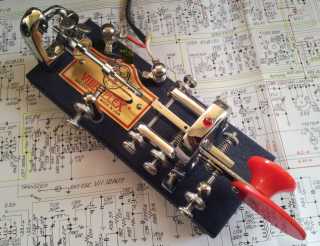

| If
you are owner of one of those beautiful and famous old
fashioned bug keyers, you might have observed a problem while sending
morse dits called bouncing. Bouncing is a fundametal problem with every
switch in electronic devices. Engineers faced those problems from the
beginning on since switches and relays where invented. Several debouncing
methods were developed over the years. One solution is to connect a
low-pass filter between the switch (morse-bug) connectors. Other
solutions are based on digital methods. I tried to solve the problem
the simplest way possible. My solution is this: just connect a 330 nF non-polarized capacitor between the bug's connectors. Be careful with the voltage rating of the capacitor if you use the bug with an ancient tube transmitter! See the manual before installing the capacitor. A 10 kOhm impedance of the keyer input was assumed which should be ok for most transceivers. If your transmitters keyer impedance is far away from the 10k you should reconsider the correct capacitors values for a succesful debouncing of your mechanic keyer. A good idea might be to use a 220 nF capacitor across the bug connectors and another 100 nF capacitor inside an usual 6,3 mm keyer jack. This can give an additional amount of RF filtering at the transmitters key plug. Here is the result of this debouncing method which is ok at speeds of about 20-30 WPM. At higher speeds the debouncing method should be improved. |